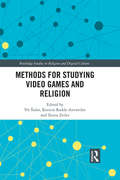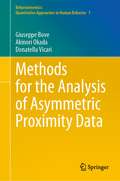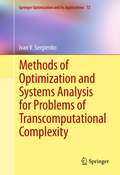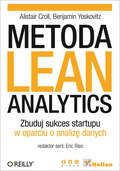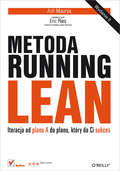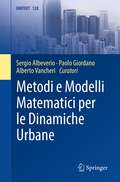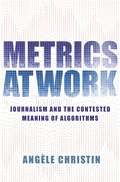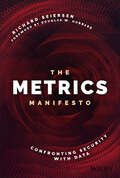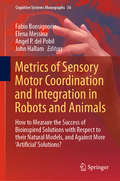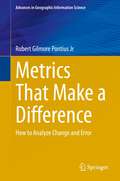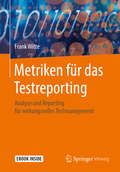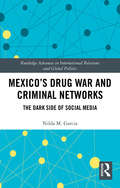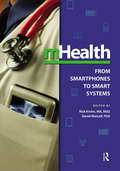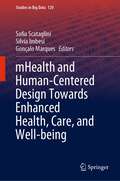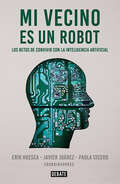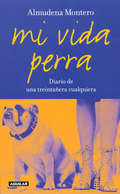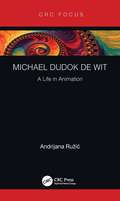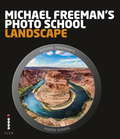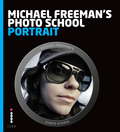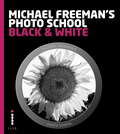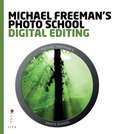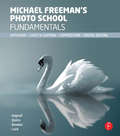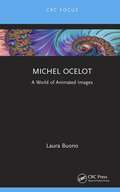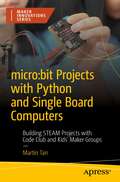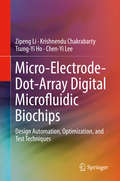- Table View
- List View
Methods for Studying Video Games and Religion (Routledge Studies in Religion and Digital Culture)
by Vít Šisler Kerstin Radde-Antweiler Xenia ZeilerGame studies has been an understudied area within the emerging field of digital media and religion. Video games can reflect, reject, or reconfigure traditionally held religious ideas and often serve as sources for the production of religious practices and ideas. This collection of essays presents a broad range of influential methodological approaches that illuminate how and why video games shape the construction of religious beliefs and practices, and also situates such research within the wider discourse on how digital media intersect with the religious worlds of the 21st century. Each chapter discusses a particular method and its theoretical background, summarizes existing research, and provides a practical case study that demonstrates how the method specifically contributes to the wider study of video games and religion. Featuring contributions from leading and emerging scholars of religion and digital gaming, this book will be an invaluable resource for scholars in the areas of digital culture, new media, religious studies, and game studies across a wide range of disciplines.
Methods for the Analysis of Asymmetric Proximity Data (Behaviormetrics: Quantitative Approaches to Human Behavior #7)
by Giuseppe Bove Akinori Okada Donatella VicariThis book provides an accessible introduction and practical guidelines to apply asymmetric multidimensional scaling, cluster analysis, and related methods to asymmetric one-mode two-way and three-way asymmetric data. A major objective of this book is to present to applied researchers a set of methods and algorithms for graphical representation and clustering of asymmetric relationships. Data frequently concern measurements of asymmetric relationships between pairs of objects from a given set (e.g., subjects, variables, attributes,…), collected in one or more matrices. Examples abound in many different fields such as psychology, sociology, marketing research, and linguistics and more recently several applications have appeared in technological areas including cybernetics, air traffic control, robotics, and network analysis. The capabilities of the presented algorithms are illustrated by carefully chosen examples and supported by extensive data analyses. A review of the specialized statistical software available for the applications is also provided. This monograph is highly recommended to readers who need a complete and up-to-date reference on methods for asymmetric proximity data analysis.
Methods of Optimization and Systems Analysis for Problems of Transcomputational Complexity
by Ivan V. SergienkoThis work presents lines of investigation and scientific achievements of the Ukrainian school of optimization theory and adjacent disciplines. These include the development of approaches to mathematical theories, methodologies, methods, and application systems for the solution of applied problems in economy, finances, energy saving, agriculture, biology, genetics, environmental protection, hardware and software engineering, information protection, decision making, pattern recognition, self-adapting control of complicated objects, personnel training, etc. The methods developed include sequential analysis of variants, nondifferential optimization, stochastic optimization, discrete optimization, mathematical modeling, econometric modeling, solution of extremum problems on graphs, construction of discrete images and combinatorial recognition, etc. Some of these methods became well known in the world's mathematical community and are now known as classic methods.
Metoda Lean Analytics. Zbuduj sukces startupu w oparciu o analiz? danych
by Alistair Croll Benjamin YoskovitzLektura obowi?zkowa dla wszystkich zainteresowanych wykorzystaniem analityki w pracach nad nowym produktem i odnoszeniem sukcesów biznesowych bez konieczno?ci wiecznego zgadywania.Peter Yared, dyrektor ds. IT, CBS InteractiveTo nie jest kolejna ksi??ka o liczbach, a rzecz o praktycznych wska?nikach. Alistair i Ben naucz? Ci?, jak przebi? si? przez mg?? danych i skupi? si? na w?a?ciwych, istotnych wska?nikach, które zadecyduj? o Twojej pora?ce lub sukcesie.Ash Maurya, za?o?yciel i dyrektor generalny Spark59 oraz WiredReach, autor ksi??ki Metoda Running LeanOkie?znane dane Jeste? przedsi?biorc?? Masz innowacyjny produkt i chcesz wej?? z nim na rynek? Mo?esz wybra? jedn? z dwóch dróg: tradycyjn?, opart? na odwiecznych m?dro?ciach starych mistrzów, albo nowoczesn?, z u?yciem modelu Lean Startup. Je?li wybra?e? pierwszy sposób - zmie? lektur?, je?li drugi - gratulacje! W tej ksi??ce znajdziesz kompletny proces analityczny, od generowania pomys?ów po przygotowanie zestawienia produktu i rynku. Dowiesz si? z niej, jak zweryfikowa? swój pomys?, znale?? odpowiednich klientów, zdefiniowa? ostateczn? wersj? produktu, zarobi? na swojej dzia?alno?ci i j? wypromowa?. Znajdziesz tu konkretne i przydatne informacje, oparte na ponad trzydziestu analizach przypadku, bez których nie mo?e si? obej?? ?aden przedsi?biorca. Ksi??ka jest skierowana równie? do analityków internetowych i analityków danych, poniewa? pozwala powi?za? efekty ich pracy z rozwa?aniami biznesowymi. Zamieszczone tu tre?ci zainteresuj? te? ludzi zaanga?owanych w rozwój produktu, zarz?dzanie nim, marketing, PR oraz dzia?alno?? inwestycyjn?, poniewa? dzi?ki nim ?atwiej b?dzie im zrozumie? i ocenia? startupy.Rewolucja w sze?ciu prostych krokachStwórz co?, co klienci pokochaj?.Zaanga?uj ludzi, aby znale?li Twój produkt i zacz?li z niego korzysta?.Poznaj model Lean Startup, podstawy analityki oraz mentalno?ci kierowania si? danymi, niezb?dnej do odniesienia sukcesu.Dowiedz si?, na którym etapie rozwoju si? znajdujesz, nad czym powiniene? pracowa? oraz jak zastosowa? model Lean Analytics we w?asnym startupie.Znajd? niez?e punkty odniesienia dla ró?nych wska?ników i naucz si? wyznacza? w?asne warto?ci docelowe.Sprawd?, w jaki sposób mo?esz zastosowa? zasady Lean Analytics w funkcjonuj?cej ju? organizacji, bo przecie? podej?cie oparte na danych sprawdza si? nie tylko w nowo powsta?ych firmach. Alistair Croll od niemal dwudziestu lat jest przedsi?biorc?, autorem ksi??ek i prelegentem. Zajmowa? si? du?ymi zbiorami danych, chmurami obliczeniowymi i startupami. W 2001 roku wspó?uczestniczy? w zak?adaniu firmy Coradiant. Od tamtej pory aktywnie pomaga wielu nowo powstaj?cym firmom i wspiera liczne startupowe imprezy.Benjamin Yoskovitz jest przedsi?biorc? z ponadpi?tnastoletnim do?wiadczeniem w bran?y internetowej. Wspó?za?o?yciel Standout Jobs i Year One Labs, pe?ni funkcj? mentora dla wielu startupów i akceleratorów przedsi?biorczo?ci. Regularnie przemawia podczas licznych konferencji po?wi?conych problematyce startupów.
Metoda Running Lean. Iteracja od planu A do planu, który da Ci sukces. Wydanie II
by Ash MauryaTo jedna z najlepszych technicznych ksi??ek na temat modelu Lean Startup. I tyle. Nic wi?cej nie trzeba dodawa?.Dan Martell, za?o?yciel, Clarity.fm, anio? biznesu Wizja testowana w praktyceWitamy w ?wiecie najnowocze?niejszych praktyk biznesowych i niezmierzonych mo?liwo?ci w dziedzinie innowacji. ?yjemy w dobie Internetu, chmur obliczeniowych i oprogramowania open source, dzi?ki czemu koszty budowania nowych produktów osi?gn??y rekordowo niski poziom. A jednak mimo wszystko szanse na to, by za?o?ony przez nas startup odniós? sukces, nie wzros?y. Dlatego w?a?nie powsta? ten podr?cznik. Jest on znakomitym narz?dziem dla szefów firm, dyrektorów generalnych, w?a?cicieli ma?ych przedsi?biorstw, deweloperów i programistów oraz ka?dego zainteresowanego stworzeniem firmy, która nie tylko przetrwa, ale b?dzie mia?a szanse liczy? si? na rynku.Running Lean to lepsza i szybsza metoda testowania pomys?ów na nowe produkty oraz opracowywania produktów, które odnios? sukces. Dzi?ki niej nauczysz si?:znajdowa? uczestników wczesnego rynku;wybiera? w?a?ciwy moment na pozyskiwanie kapita?u z zewn?trz;testowa? ceny;tworzy? i mierzy? to, czego chc? klienci;maksymalizowa? podejmowane dzia?ania pod k?tem szybko?ci uczenia si? i koncentracji;rozpoznawa? zestawienie produktu i rynku;d??y? w sposób powtarzalny do opracowywania produktów odpowiadaj?cych potrzebom rynku.Przeczytaj równie?: Metoda Lean Startup. Wykorzystaj innowacyjne narz?dzia i stwórz firm?, która zdob?dzie rynek, Eric Ries, Helion 2012.Ash Maurya - za?o?yciel firmy Spark59. Za?o?y? równie? kilka innych startupów, w?ród których znalaz?y si? tak udane przedsi?wzi?cia, jak WiredReach. Dzi?ki prowadzonym przez siebie warsztatom Running Lean blisko wspó?pracuje z wieloma przedsi?biorcami, którym pomaga testowa? i dopracowywa? ich wizj?. Ash pe?ni funkcj? mentora w wielu inkubatorach przedsi?biorczo?ci na ca?ym ?wiecie, w tym w Mozilla Foundation, Year One Labs oraz Capital Factory.
Metodi e Modelli Matematici per le Dinamiche Urbane (UNITEXT #128)
by Sergio Albeverio Paolo Giordano Alberto VancheriIl testo presenta metodi e modelli per lo studio delle città viste come sistemi evolutivi che interagiscono con il territorio circostante. Gli aspetti morfologici, strutturali e dinamici sono sottolineati e analizzati con metodi qualitativi e quantitativi originati dalla matematica e dalla fisica, ma anche ispirati da altre scienze naturali e dallo studio dei sistemi socio-economici. Il libro usa la matematica in vari modi: i concetti e i metodi che vanno oltre quelli della matematica elementare vengono introdotti ed esposti brevemente, con particolare attenzione a quelli attinenti a probabilità e statistica che, non facendo parte dell'educazione di base, vengono presentati sistematicamente tramite capitoli appositi. Contributi più specializzati includono argomenti come la dinamica urbana, l'analisi di progetti architettonici per il territorio, l'uso di automi cellulari stocastici, la sintassi dello spazio urbano, l'influenza del paesaggio e della geografia, e i modelli per la mobilità urbana. Il libro è rivolto agli studenti di corsi avanzati di architettura, urbanistica e ingegneria, e a tutte le persone che studiano il territorio o vi operano.
Metrics at Work: Journalism and the Contested Meaning of Algorithms
by Angele ChristinThe starkly different ways that American and French online news companies respond to audience analytics and what this means for the future of newsWhen the news moved online, journalists suddenly learned what their audiences actually liked, through algorithmic technologies that scrutinize web traffic and activity. Has this advent of audience metrics changed journalists’ work practices and professional identities? In Metrics at Work, Angèle Christin documents the ways that journalists grapple with audience data in the form of clicks, and analyzes how new forms of clickbait journalism travel across national borders.Drawing on four years of fieldwork in web newsrooms in the United States and France, including more than one hundred interviews with journalists, Christin reveals many similarities among the media groups examined—their editorial goals, technological tools, and even office furniture. Yet she uncovers crucial and paradoxical differences in how American and French journalists understand audience analytics and how these affect the news produced in each country. American journalists routinely disregard traffic numbers and primarily rely on the opinion of their peers to define journalistic quality. Meanwhile, French journalists fixate on internet traffic and view these numbers as a sign of their resonance in the public sphere. Christin offers cultural and historical explanations for these disparities, arguing that distinct journalistic traditions structure how journalists make sense of digital measurements in the two countries.Contrary to the popular belief that analytics and algorithms are globally homogenizing forces, Metrics at Work shows that computational technologies can have surprisingly divergent ramifications for work and organizations worldwide.
The Metrics Manifesto: Confronting Security with Data
by Richard SeiersenSecurity professionals are trained skeptics. They poke and prod at other people’s digital creations, expecting them to fail in unexpected ways. Shouldn’t that same skeptical power be turned inward? Shouldn’t practitioners ask: “How do I know that my enterprise security capabilities work? Are they scaling, accelerating, or slowing as the business exposes more value to more people and through more channels at higher velocities?” This is the start of the modern measurement mindset—the mindset that seeks to confront security with data. The Metrics Manifesto: Confronting Security with Data delivers an examination of security metrics with R, the popular open-source programming language and software development environment for statistical computing. This insightful and up-to-date guide offers readers a practical focus on applied measurement that can prove or disprove the efficacy of information security measures taken by a firm. The book’s detailed chapters combine topics like security, predictive analytics, and R programming to present an authoritative and innovative approach to security metrics. The author and security professional examines historical and modern methods of measurement with a particular emphasis on Bayesian Data Analysis to shed light on measuring security operations. Readers will learn how processing data with R can help measure security improvements and changes as well as help technology security teams identify and fix gaps in security. The book also includes downloadable code for people who are new to the R programming language. Perfect for security engineers, risk engineers, IT security managers, CISOs, and data scientists comfortable with a bit of code, The Metrics Manifesto offers readers an invaluable collection of information to help professionals prove the efficacy of security measures within their company.
Metrics of Sensory Motor Coordination and Integration in Robots and Animals: How to Measure the Success of Bioinspired Solutions with Respect to their Natural Models, and Against More ‘Artificial’ Solutions? (Cognitive Systems Monographs #36)
by Fabio Bonsignorio Elena Messina Angel P. del Pobil John HallamThis book focuses on a critical issue in the study of physical agents, whether natural or artificial: the quantitative modelling of sensory–motor coordination.Adopting a novel approach, it defines a common scientific framework for both the intelligent systems designed by engineers and those that have evolved naturally. As such it contributes to the widespread adoption of a rigorous quantitative and refutable approach in the scientific study of ‘embodied’ intelligence and cognition. More than 70 years after Norbert Wiener’s famous book Cybernetics: or Control and Communication in the Animal and the Machine (1948), robotics, AI and life sciences seem to be converging towards a common model of what we can call the ‘science of embodied intelligent/cognitive agents’. This book is interesting for an interdisciplinary community of researchers, technologists and entrepreneurs working at the frontiers of robotics and AI, neuroscience and general life and brain sciences.
Metrics That Make a Difference: How to Analyze Change and Error (Advances in Geographic Information Science)
by Robert Gilmore Pontius JrYour government warns that 10% of your neighbors have a deadly contagious virus. The producer of a diagnostic test advertises that 90% of its tests are correct for any population. The test indicates that you have the virus. This book’s author claims your test has a 50% chance of being false, given your test’s result. Who do you believe? This book gives you insights necessary to interpret metrics that make a difference in life’s decisions.This book gives methods and software that are essential to analyze change and error. Change describes a phenomenon across time points. Error compares diagnoses with the truth. Other texts give insufficient attention to these topics. This book’s novel ideas dispel popular misconceptions and replace previous methods. The author uses carefully designed graphics and high school mathematics to communicate easily with college students and advanced scientists. Applications include but are not limited to Remote Sensing, Land Change Science, and Geographic Information Science.“A wide range of tools to aid understanding of land cover and its change has been used but scientific progress has sometimes been limited through misuse and misunderstanding. Professor Pontius seeks to rectify this situation by providing a book to accompany the researcher’s toolbox. Metrics That Make a Difference addresses basic issues of relevance to a broad community in a mathematically friendly way and should greatly enhance the ability to elicit correct information. I wish this book existed while I was a grad student.” – Giles Foody, Professor of Geographical Information Science, The University of Nottingham“Metrics That Make a Difference provides a comprehensive synthesis of over two decades of work during which Dr. Pontius researched, developed, and applied these metrics. The book meticulously and successfully guides the reader through the conceptual basis, computations, and proper interpretation of the many metrics derived for different types of variables. The book is not just a mathematical treatise but includes practical guidance to good data analysis and good science. Data scientists from many fields of endeavor will benefit substantially from Dr. Pontius’ articulate review of traditionally used metrics and his presentation of the innovative and novel metrics he has developed. While reading this book, I had multiple ‘aha’ moments about metrics that I shouldn't be using and metrics that I should be using instead.” – Stephen Stehman, Distinguished Teaching Professor, State University of New York
Metriken für das Testreporting
by Frank WitteZu jeder Softwareentwicklung gehört es dazu, das Management regelmäßig über Fortschritte und etwaige Probleme des Projekts zu informieren. Dieses Buch stellt verschiedene Testgrößen und Metriken vor, mit denen sich Fortschritte im Rahmen eines Softwaretests plastisch darstellen lassen und Handlungsbedarf leicht zu identifizieren ist. Detailreich werden dazu die für ein erfolgreiches Reporting wesentlichen Kenngrößen und Indexwerte erklärt. Ausgehend von der historischen Entwicklung des Testreportings erläutert der Autor den grundsätzlichen Nutzen der Metriken und gibt einen Überblick darüber, welche verschiedenen Arten von Metriken es gibt und wie sie im Softwaretest sinnvoll eingesetzt werden können. Er zeigt, wie sich, angefangen bei der Testspezifikation über die Testdurchführung bis hin zur Entwicklung der Testabdeckung, eine bestimmte Metrik individuell auf eine zu testende Software abstimmen lässt und wie man dadurch eine Automatisierung der Tests erreichen kann. Daneben stellt er Vorzüge und Nachteile jener Testmetriken auf, die auf Fehlern basieren, also die die Fehleranzahl, die Fehlerdichte und die Entwicklung der Fehler im Zeitverlauf messen. Mit dieser ausführlichen Auseinandersetzung mit dem Testreporting liefert der Autor eine optimale Bewertungsgrundlage, mit der sich nicht nur einschätzen lässt, welche Testmetrik man für welchen Einsatzzweck bzw. welche individuellen Projektsituation verwenden sollte, sondern auch, worin besondere Probleme einer einzelnen Metrik für das Testreporting bestehen können und wie man diese Probleme am besten löst. Damit richtet sich dieser praktische Leitfaden vor allem an Mitarbeiter in IT-Projekten, wie Projektleiter, Softwaretester und Entwickler, aber auch Unternehmens- und Technologieberater sowie Dozenten an Hochschulen und Universitäten finden hier einen spannenden Einblick in verschiedene Methoden des Softwaretestings.
Mexico's Drug War and Criminal Networks: The Dark Side of Social Media (Routledge Advances in International Relations and Global Politics)
by Nilda M. GarciaMexico's Drug War and Criminal Networks examines the effects of technology on three criminal organizations: the Sinaloa cartel, the Zetas, and the Caballeros Templarios. Using social network analysis, and analyzing the use of web platforms Facebook, Twitter, and YouTube, Nilda M. Garcia provides fresh insights on the organizational network, the central nodes, and the channels through which information flows in these three criminal organizations. In doing so, she demonstrates that some drug cartels in Mexico have adopted the usage of social media into their strategies, often pursuing different tactics in the search for new ways to dominate. She finds that the strategic adaptation of social media platforms has different effects on criminal organization’s survivability. When used effectively, coupled with the adoption of decentralized structures, these platforms do increase a criminal organization’s survival capacity. Nonetheless, if used haphazardly, it can have the opposite effect. Drawing on the fields of criminology, social network analysis, international relations, and organizational theory and featuring a wealth of information about the drug cartels themselves, Mexico's Drug War and Criminal Networks will be a great source for all those interested in the presence, behavior, purposes, and strategies of drug cartels in their forays into social media platforms in Mexico and beyond.
mHealth: From Smartphones to Smart Systems (HIMSS Book Series)
by Mas, Metcalf David Rick Krohn Ma, Mas, Metcalf David Rick Kroh MamHealth: From Smartphone to Smart Systems provides a high level and comprehensive survey of the emergence of mobile technology healthcare. This book looks beyond the already-popular devices and apps associated with mHealth, exploring the major role this technology could play as healthcare steers inexorably toward an architecture
mHealth and Human-Centered Design Towards Enhanced Health, Care, and Well-being (Studies in Big Data #120)
by Sofia Scataglini Silvia Imbesi Gonçalo MarquesThe book examines the current state of mHealth and Human-Centered Design (HCD) initiatives toward health, care, and well-being. The present surge in interest in improving people's quality of life is creating new prospects for the development of innovative design solutions aimed at enhancing living conditions. The combination of emerging user needs and opportunities provided by recent innovative mHealth technologies enables research institutions, stakeholders, and academia to design new solutions to promote well-being, health, and care, thereby improving the quality of life of people of all ages. The book analyzes and discusses the most innovative services, products, and systems in the healthcare field. This strategy is in line with the concept of ambient assisted living or enhanced living environment, which focuses on the comfort and health of specific categories of users.This book covers several topics highlighting the importance of involving end-users in the design of innovative solutions in digital health care, and design considerations of mobile healthcare applications.Furthermore, the covered topics are described in their current applications in relevant fields focusing on the design of smart solutions, such as biomonitoring systems, activity recognition tools, smart living environments, physical autonomy, and virtual assistance.This editorial project is addressed to academics, designers, engineers, and practitioners in health care who want to promote cooperation between academia, stakeholders, and research institutions.
Mi vecino es un robot
by Cicero, Paola Juarez Mojica, JavierUn mosaico que refleja la complejidad de una ciencia joven que ya no es producto de una sola rama del conocimiento humano, sino de la interdependencia de todo nuestro conocimiento. Un conjunto de ensayos de expertos que evidencian cada uno de los aspectos más problemáticos de la Inteligencia Artificial con la realidad mexicana. En Mi vecino es un robot se busca explorar qué es la Inteligencia artificial más allá de la categoría simplista que se le ha otorgado como tecnología. Busca abordar algunos de los principales mitos y crear una amalgama que refleje el valor de un área en desarrollo del conocimiento humano, abriendo al lector los caminos por desarrollar y explorar que tiene como ciencia y promoviendo, en algunos casos, una perspectiva crítica sobre sus retos e implicaciones. En la medida que entendamos a la IA, sus impactos y sus retos, estaremos en condiciones de proponer medidas, como lectores y como sociedad, sobre cuál es el rumbo que queremos seguir a fin de que la tecnología no se convierta en otro factor de desigualdad.
Mi vida perra: Diario de una treintañera cualquiera
by Almudena MonteroMi vida perra es una sucesión de textos tan directos y vivos como el día a día que reflejan. Tan sorprendentes y cambiantes como las formas de relación en la nueva era de internet. «Lo malo de vivir sola es que pasas demasiado tiempo mirándote la bragueta. Y cuando observas mucho algo, no suele gustarte demasiado. Entonces te regañas, te peleas contigo misma, te largas con el perro dando un portazo, o mejor al cine y así no tienes que seguir escuchándote. Al salir, te apetece hablar con alguien, pero a ver a quién le cuentas que ya no te soportas, que no puedes más, o que te vas a separar de ti misma por culpa de tus problemas de convivencia.» Los textos de Mi vida perra han sido extraídos del blog de Almudena Montero, escritora y guionista que un día decidió compartir su intimidad a través de la pantalla de su ordenador. Durante unos meses nos infiltramos en su apartamento y asistimos a cuanto vive, piensa, desea o tan solo imagina. La soledad, el desencuentro con la pareja, el sexo casual, los amigos de toda la vida, los paseos con su perro Baldo o las crisis de identidad ocupan estas páginas, teñidas de ironía ácida y de un sentido del humor iconoclasta.
Michael Dudok de Wit: A Life in Animation
by Andrijana RuzicThis unique survey of the career of Michael Dudok de Wit discusses all of his works and offers a glimpse into his private life. The biography of this European master of 2D animation, born in the Netherlands and based in London, is the first complete overview of the well-defined and canonic opus of this humble genius. Visually and thematically, Dudok de Wit’s poetic and singular style of animation differs from the rest of contemporary independent animation production. This book reveals what still challenges and thrills Dudok de Wit in the art of animation and why he persistently continues to believe in the beauty of hand-drawn animation. Key Features The complete animation production of Michael Dudok de Wit, never-before reviewed in one volume An all-embracing approach regarding this auteur, unavailable elsewhere in one place (his biography, his peculiar method of work, his extracurricular activities) An ad hoc glossary of animation written by Michael Dudok de Wit and a critical reception of his body of work with a wide contribution of his colleagues and collaborators Filmography and bibliography Author Andrijana Ružić graduated in History and Criticism of Art at the Universita degli Studi in Milan, Italy, where she fell in love with the medium of animation. She specialised in the History of Animated Film under Giannalberto Bendazzi’s mentorship. For the past six years, she has curated the section dedicated to animated films at the International Comics Festival in Belgrade, Serbia. She is a member of the Selection Board of Animafest Scanner, the symposium for Contemporary Animation Studies at the World Festival of Animated Film held annually in Zagreb, Croatia. She writes about animation and art for the Belgrade weekly magazine Vreme.
Michael Freeman's Photo School: Landscape (Michael Freeman's Photo School)
by Michael FreemanThe classic genre that has been a fundamental part of photography since the beginning, landscape has perennial appeal to all photographers. Michael Freeman shares his wealth of experience in this comprehensive guide to art of capturing beautiful landscapes.Start your exploration of this vast subject by deconstructing and studying its elements-from the most reliable locations to the classic compositions. Next, learn how to find and position yourself in the optimal viewpoints for original and creative interpretations of these massive subjects. Using the right gear and techniques for each frame, you will be able to capture depth and dimensionality that speak to the grandeur of these exotic locations. With the sky as your studio, you can make the weather work for you to provide a stunning variety of spectacular light.Going beyond the purely technical side, Freeman also dives into the mind of the landscape photographer, addressing the environment, studying how distinct colour palettes can evoke moods, and following in the illustrious tradition of B&W landscapes. The studio will start to feel very small indeed once you start exploring the great outdoors!
Michael Freeman's Photo School: Portrait (Michael Freeman's Photo School)
by Michael FreemanAt some point, all photographers are called upon to shoot a proper portrait - combining technical skill with personable demeanour to capture someone in their best possible light. Michael Freeman teaches you how to achieve flattering portrait results with a variety of both traditional and modern styles.Learn how to set your subjects at ease and bring out their natural beauty with a friendly yet professional attitude. Feel confident giving directions on posing and stance with a thorough review of the classic approaches, from head-and-shoulder shots to full-length compositions, and everything in between.Take creative control of your portrait sessions by learning to manipulate the light to your own ends - whether that means bouncing sunlight o a reflector or building your own studio setups with multiple fl ash units. The complex science of photographic lighting is explained in straightforward and easy-to-understand language, with abundant and inspirational examples. Finally, master the fundamentals of post-production finishing techniques to make sure every portrait looks its absolute best. Your subjects will thank you for it!
Michael Freeman's Photo School: Black And White (Michael Freeman's Photo School)
by Michael FreemanFrom timeless, elegant portraits to gritty, graphic street shots, the possibilities of black and white are endless, enticing, and exciting. Recognising this potential within every shot, and knowing the digital-editing tools and techniques to maximize its effect are essential steps to building up your photographic repertoire.Having first established the fundamental aesthetic choices that go into every B&W conversion, Michael Freeman goes on to review the noble tradition of black and white, detailing its numerous styles and fashions, with step-by-step instructions on how to achieve each effect, regardless of your particular software. Presented in a straightforward and easy-to-understand format, you will soon be able to both visualise exactly how you want your final image to appear, and achieve that signature look with efficient workflows and powerful conversion techniques.These skills open up new worlds of photographic opportunity everywhere you look, and encourage artistic growth just as much as they inspire you to try new styles and exciting treatments.
Michael Freeman's Photo School: Digital Editing: Essential Aspects Of Digital Editing (Michael Freeman's Photo School)
by Michael FreemanUnlock the full potential of each and every image with reliable post-production techniques that will become a fundamental part of your photography. Using easily followed, step-by-step instructions, Michael Freeman demystifies the complexities of today's high-powered editing programs to provide you with effective digital workflows tailored to your particular photographic style, and using whichever editing programs you are most comfortable with.Begin by exploring the fundamental aspects of image optimisation, from fixing exposure and making colour adjustments, to sharpening and noise reduction - essential steps that elevate simple snapshots to stunning images. Then move on to explore the advanced possibilities of black-and-white conversion, panoramic stitching, HDR imaging, and more. Learn to recognise the right tools for the job, saving you time on the computer and ensuring each image gets the treatment it deserves.Whether you're salvaging an underexposed shot or building a composite of multiple images, these techniques will give your photography a professional and refined style.
Michael Freeman's Photo School Fundamentals: Exposure, Light & Lighting, Composition
by Michael FreemanPhotography is international best-seller Michael Freeman’s life, and in this book he works together with fellow photography experts to share his and their knowledge with anyone who wants to learn not only how to take better photos, but also why those photographs work and where they fit in with the history of the craft. Inspired by the structure of a college course and the benefits of a collective learning environment, this book teaches the fundamentals of photography not just through comprehensive lessons and instructions, but also through challenges in which readers can participate. Sample work from Michael’s students provides inspiration, and critical evaluations of the results ensure that the core concepts are being grasped every step of the way. Additionally, readers can join in by sharing their work via the series’ dedicated website.
Michel Ocelot: A World of Animated Images
by Laura BuonoThis unique book examines the career of Michel Ocelot, from his earliest works to his latest research and productions, including an interview regarding his latest film Le Pharaon, le Sauvage et la Princesse (2022). The book highlights the director’s role in the panorama of contemporary animated cinema and his relationship with the tradition, both artistic and cinematographic. The book carefully analyses the ethical and social nature of Ocelot’s work to underscore the duality of the director’s oeuvre, both artistic and social, using an interdisciplinary approach that blends film and aesthetic criticism with gender studies and decolonial thought. Particular attention will be given to the themes of multiculturalism, discrimination, and treatment of women, which are at the centre of many current cultural debates. The book will be of interest to an audience of experts, animation enthusiasts, and film scholars, as well as to a wider readership interested in learning about the poetics of Kirikou’s father.
micro: Building STEAM Projects with Code Club and Kids' Maker Groups
by Martin TanBuild different components of larger systems using class sets of micro:bits with Python in a truly collaborative way. First you’ll explore ways to harness the capabilities of the humble micro:bit and learn to creatively overcome some of its limitations; learning practical text-based programming along the way. We’ll then move on to building projects that allow multiple micro:bits, and other microcontroller boards and parts like the Raspberry Pi, to communicate with one another, and coordinate their operations to build larger systems.Rather than just being a guide to learning these skills, this book will include tips and stories about implementing the these ideas in classrooms, Code Clubs, and Maker environments. Practical logistics for preparation and easy set-up, as well as, acceptance criteria and accountability for students and participants is included. These ideas were gained over years of running a Code Club and running Maker workshops and events.You’ll learn about programming collaborative solutions and design logic. Then you’ll scale that logic up to more complex projects. By the end, you’ll have added additional electronic and physical components to projects that interact with the world. You’ll create fun inventions together, using hardware, coding, electronics, physical objects, and e-textiles.What You'll LearnSolve problems and create art by modelling solutions and ideas with a combination of Python coding, electronic systems engineering, and creative design.Navigate the logistical and unique challenges that come with running your own Code Club, Makerspace, or feeding these activities into STEAM design and technology curriculums.Take new Makers from simply copying and duplicating through to debugging and understanding.Who This Book Is ForMakers and instructors interested in starting group projects while learning to code and gain other Maker skills along the way. Essential information is provided in a form that enables beginners and intermediate Makers to get hands-on quickly, but with enough depth to keep building on these projects and pushing the boundaries.
Micro-Electrode-Dot-Array Digital Microfluidic Biochips: Design Automation, Optimization, And Test Techniques
by Zipeng Li Krishnendu Chakrabarty Tsung-Yi Ho Chen-Yi LeeThis book provides an insightful guide to the design, testing and optimization of micro-electrode-dot-array (MEDA) digital microfluidic biochips. The authors focus on the characteristics specific for MEDA biochips, e.g., real-time sensing and advanced microfluidic operations like lamination mixing and droplet shape morphing. Readers will be enabled to enhance the automated design and use of MEDA and to develop a set of solutions to facilitate the full exploitation of design complexities that are possible with standard CMOS fabrication techniques. The book provides the first set of design automation and test techniques for MEDA biochips. The methods described in this book have been validated using fabricated MEDA biochips in the laboratory. Readers will benefit from an in-depth look at the MEDA platform and how to combine microfluidics with software, e.g., applying biomolecular protocols to software-controlled and cyberphysical microfluidic biochips.
